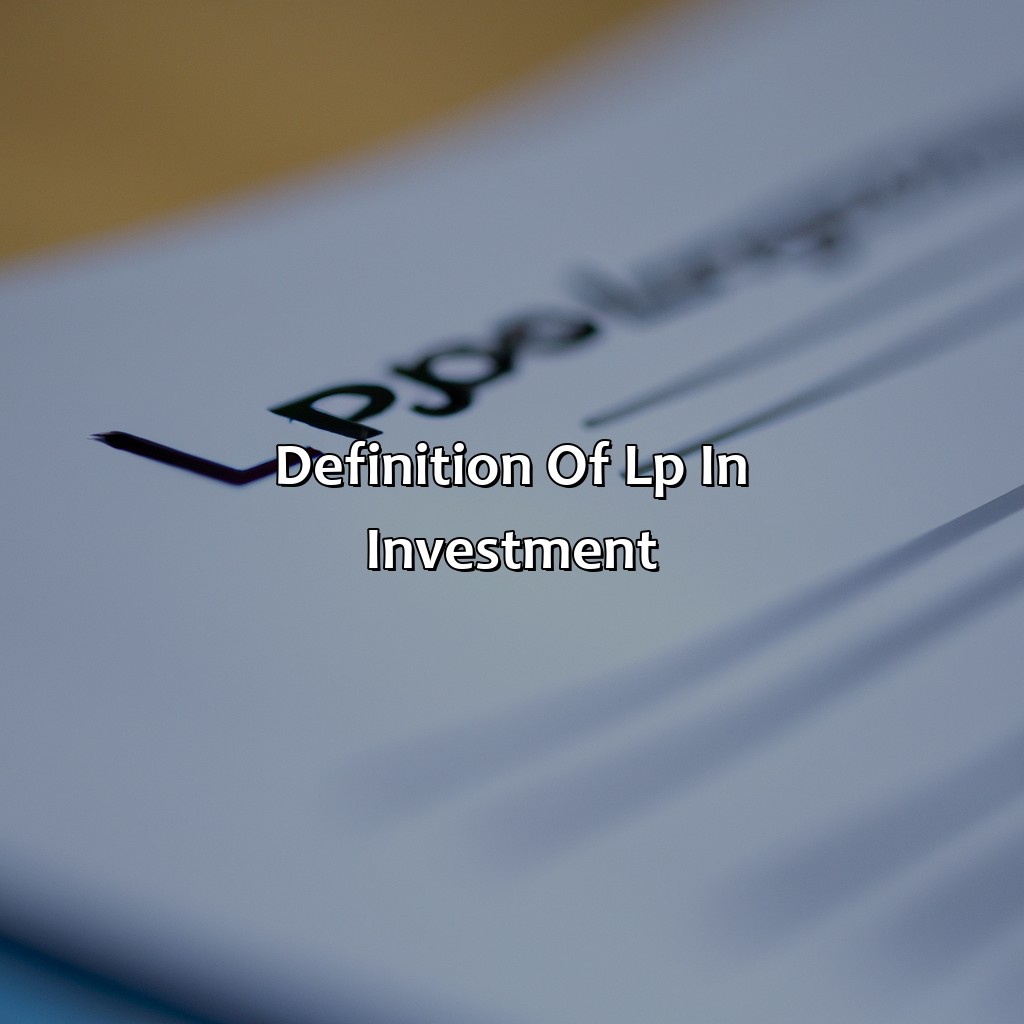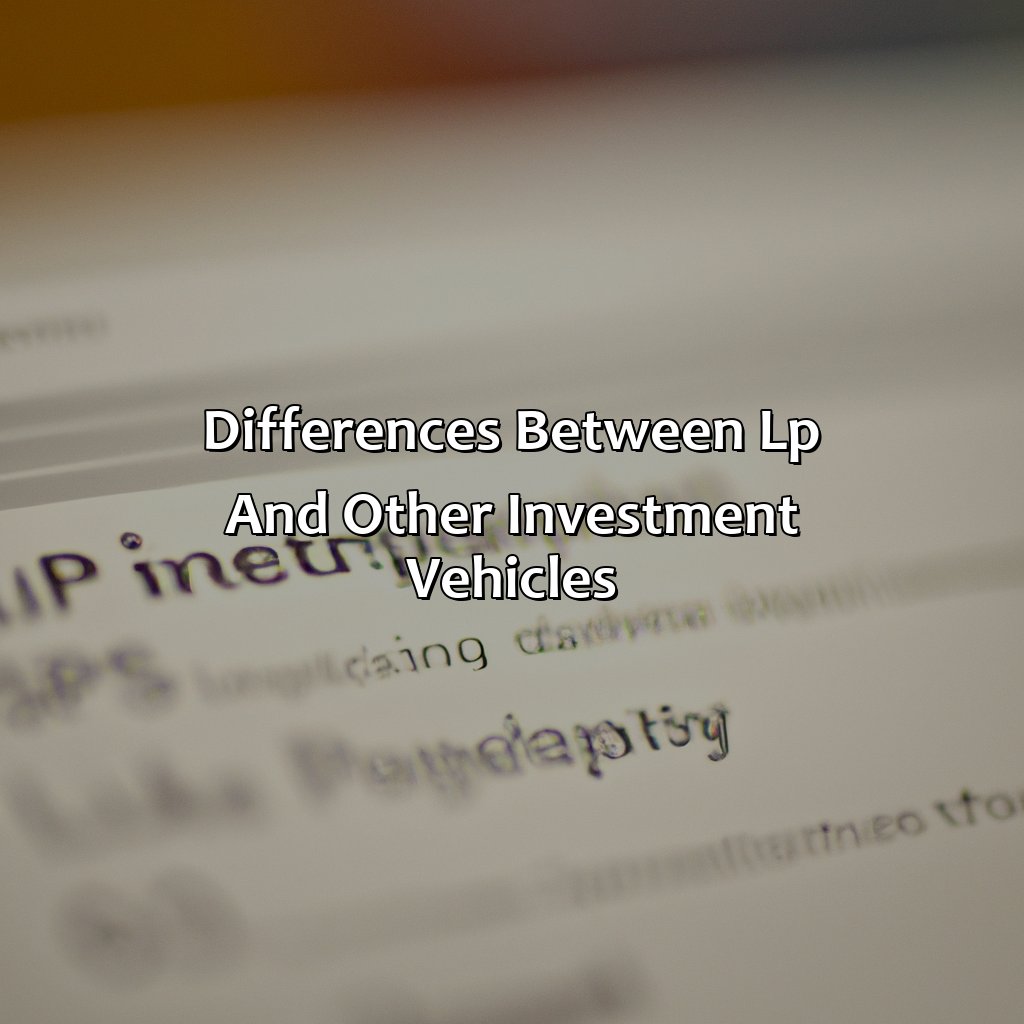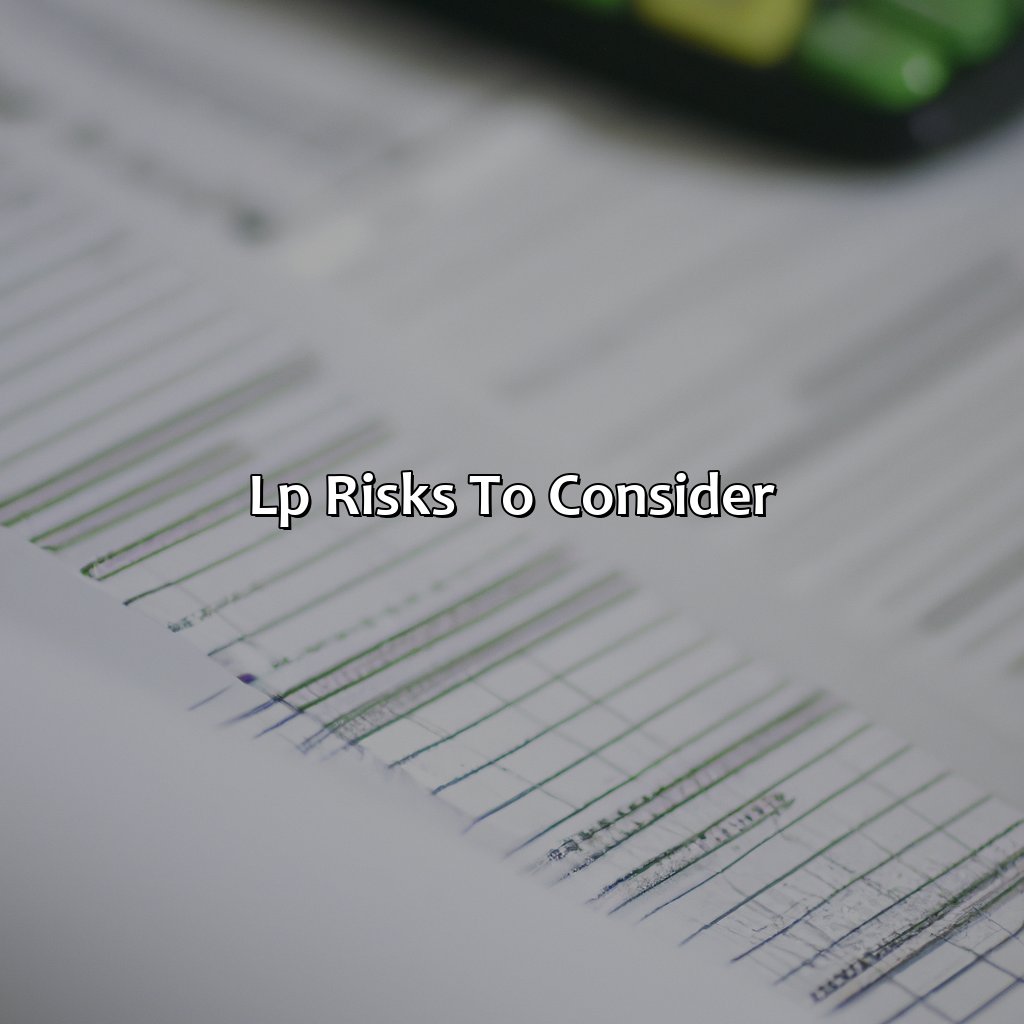What Is Lp In Investment?
Key Takeaway:
- LP in investment stands for Limited Partnership, which is a type of investment structure in which one or more general partners manage the business and are personally liable for its debts, while limited partners provide capital and have limited liability for the partnership’s debts. This form of investment offers a way for individuals to invest in private businesses and gain exposure to different markets while limiting their liability.
- LP in investment provides diversification of investment portfolio, allowing investors to spread their risk across different industries and asset classes. It also offers limited liability protection for the limited partners, ensuring that their potential losses are limited to the amount of their investment. Additionally, LP structures in investment allow for passive investment, enabling investors to participate in the profits of the partnership without actively managing the business.
- LP structures in investment can take different forms, including Limited Partnership (LP), Master Limited Partnership (MLP), and Publicly Traded Partnership (PTP), each with its own benefits and risks. Understanding the differences between these structures is important when deciding on an investment strategy.
Do you feel lost when it comes to LP investments? Don’t worry, this article will clear up any confusion you have about the term and its importance in investments. You’ll become an expert in no time!
Definition of LP in Investment
LP in investment refers to Limited Partnerships, where investors provide capital and receive profits based on their percentage ownership. LPs have no role in the management of the company and are only liable for their invested amount. LPs also enjoy tax benefits. The General Partner is responsible for managing the company and making operational decisions.
LPs are preferred by investors looking for passive income and diversification of their portfolio, without taking much risk. The model is ideal for private equity ventures which require significant capital and run on a long-term basis.
It is essential to have a legal partnership agreement in place, with clearly defined roles, responsibilities and distribution of profits. The agreement should also specify terms for exit, such as buyouts or sales.
A study by McKinsey & Company found that LPs investing in private equity saw a median net return of 13% in Q2 2020, outperforming public equity markets by a significant margin.

Image credits: retiregenz.com by Harry Jones
Benefits of LP in Investment
Maximize your investment gains by utilizing limited partners (LPs). Diversify your portfolio, receive limited liability protection, and invest passively. LPs provide an outstanding base for your investment approach.

Image credits: retiregenz.com by Harry Duncun
Diversification of Investment Portfolio
One key advantage of utilizing LP in investment is the ability to create a diversified investment portfolio. This enables investors to spread their investments across different asset classes, geographies, and sectors. By creating a diverse portfolio, investors can minimize the overall risks of their investments by reducing their exposure to any one particular type of asset or market. Additionally, diversification provides the opportunity for greater returns as it allows for potential gains in multiple areas.
Investing with LPs opens up opportunities to invest in a wider range of assets such as real estate, private equity, hedge funds and other alternative assets. This allows for a more sophisticated investment strategy that isn’t hindered by traditional barriers such as high minimum investment amounts or limited access. Diversifying through LP investment also offers an added layer of professional management and expertise.
A unique aspect of investing through LPs is the potential for partnerships. Investors can collaborate with experienced fund managers who have established track records and deep domain knowledge. This offers the possibility for substantial growth opportunities that may not have been possible otherwise. Choosing reliable partners can add immense value to an investment portfolio, especially in risky economic times.
Investors seeking diversification can benefit from exploring LPs, which offer a variety of sophisticated and innovative approaches to investing across many different industries. These include real estate development projects and venture capital investments focused on emerging technologies or markets. By teaming up with professional fund managers or leveraged buyout firms, investors can pool their collective resources and make larger investments than would be possible alone while mitigating risk levels through diversification strategies.
Protecting your assets while investing? Sounds too good to be true, but with limited liability protection, you can finally sleep at night without counting sheep (or stocks).
Limited Liability Protection
When investing in a Limited Partnership (LP), investors are granted Limited Liability Protection. This means that their personal assets can’t be held liable for the debts and legal obligations of the partnership. In simpler terms, if the company goes bankrupt or is sued, the investor’s personal assets aren’t at risk. LPs provide a level of security to investors and allow them to take calculated risks without having to jeopardize their financial standing.
Investors benefit from Limited Liability Protection as it safeguards them from any financial fallout that may occur due to business ventures gone awry. The protection also encourages entrepreneurs to start new businesses as it lowers the risk associated with investment and promotes more significant spending power. By limiting the liability of investors, LPs assure a level playing field where everyone has an equal opportunity to participate in high-risk ventures.
It’s essential to note that every state has its own legal requirements when creating an LP. LP agreements must specify how profits will be distributed among partners, how management decisions will be made, and what percentage each partner holds in the partnership. The agreement may also outline procedures for how the partnership will dissolve if needed.
An example of how Limited Liability Protection benefits investors can be seen in the collapse of Enron Corporation. The corporation was structured as an LP, which meant that Enron’s limited partners had maximum exposure limited to their investment amount only. They were protected from being forced to pay out-of-pocket for any debts incurred by Enron Corporation.
Passive investing is like enjoying a smooth ride in a self-driving car, while active investing is like driving a manual transmission during rush hour traffic.
Passive Investment
Passive investing is a method for investors to grow wealth over the long term, without active involvement in individual trades or assets. This strategy requires minimal effort on the part of the investor, with funds placed into a portfolio or index that tracks a particular set of securities. The goal is to achieve returns that are similar to the overall market performance.
Such investments ensure that there is no need for constant monitoring of individual investments and can be managed by professionals in investment firms. They offer access to markets and portfolios that may otherwise be unavailable to smaller investors. This type of investing comes with lower fees because of its passive management style.
One unique benefit of passive investment is its ability to reduce risk through diversification across an array of stocks. Since it invests in a broad selection of assets, rather than being concentrated on single assets, or companies, exposure to risks and losses are minimized.
The first known example of passive investing was created by American economist Eugene Fama at the University of Chicago which became Modern Portfolio Theory. In 1975, John Bogle founded Vanguard Funds using this theory as its foundation.
LP structures in investment are like puzzles – complex, confusing, but once solved, can lead to great rewards.
LP Structures in Investment
To grasp LP structures in investing, there are three solutions: Limited Partnership (LP), Master Limited Partnership (MLP), and Publicly Traded Partnership (PTP). Let’s look at each one. We’ll outline the pros and cons of investing in them.

Image credits: retiregenz.com by Adam Jones
Limited Partnership (LP)
LP investment structures involve a partnership where some partners hold limited liability while others have general liability. Limited partners can’t make operational decisions and take no responsibility for the company’s debts, whereas general partners have more control and are liable for company obligations. The LP structure allows for a more flexible organizational setup with increased access to capital.
It’s essential to note that in an LP structure, only the general partner is responsible for making managerial decisions and can be held accountable if the company fails. The limited partner is merely an investor or silent partner, not involved in any business operations.
Investing through an LP structure offers significant advantages, such as limited personal liability and potential tax breaks. However, it requires extensive research to ensure you’re partnering with competent management who have experience running successful businesses.
LP structures offer unique opportunities to investors looking to diversify their portfolio and gain exposure in industries they wouldn’t otherwise have access to. With careful consideration and professional guidance, investing through an LP structure can generate significant returns on investment.
Don’t miss out on the chance to explore this lucrative investment avenue – consult a financial advisor today to learn more about LP structures and how they could benefit your financial goals.
MLPs: where you can invest in energy and still have enough money left over to fill up your gas tank.
Master Limited Partnership (MLP)
Master Limited Partnership (MLP) is a type of business structure that combines the benefits of a limited partnership with the liquidity of publicly traded companies. This structure provides tax benefits and allows investors to own units instead of shares. MLPs are typically found in energy, real estate, and natural resources industries.
MLPs have the unique feature of distributing most of their income to the unit holders, thereby reducing taxes for both the MLP and its investors. Additionally, the units can be traded on major exchanges like stocks without triggering a tax event. This makes MLPs an attractive option for income-seeking investors who want exposure to historically stable industries.
It is important to note that not all partnerships are eligible for MLP status – they must derive at least 90% of their income from qualified sources such as transportation, storage and processing of natural resources. Furthermore, some states do not recognize MLPs as legal entities which can complicate matters when investing.
Pro Tip: Before investing in an MLP, it is important to understand the underlying assets and industry dynamics to ensure stable cash flows and long-term growth potential.
Why gamble your money at a actual casino when you can invest in a Publicly Traded Partnership and let the stock market gamble for you?
Publicly Traded Partnership (PTP)
Investing in a partnership with publicly-traded units is commonly known as PTP’s. These structures enable investors to hold an ownership interest in companies that are taxed as partnerships while also offering liquidity like that of a public company.
PTP’s came into existence following the Tax Reform Act of 1986, which granted limited liability partners a public trading status, allowing widespread accessibility to investment opportunities once reserved for private partnerships. PTP’s are typically found in the energy, natural resource, and real estate sectors and provide tax advantages for investors through return on capital invested.
It’s worth noting PTP’s carry different tax implications than corporations and require unique considerations before investing. Partner-level taxation is applied to income generated from these investments versus corporate level taxation, subjecting partners to higher effective tax rates. Thus, prospective investors must weigh the benefits against these considerations before deciding if PTP’s align with their portfolio objectives.
LPs may sound like a fancy car brand, but they’re actually the vehicle you need for investment success.
Differences between LP and other Investment Vehicles
In investment, Limited Partnerships (LP) differ from other investment vehicles. Here are the key differences:
| Differentiator | Explanation |
|---|---|
| Tax benefits | LPs have lower tax liabilities compared to other vehicles. |
| Investment Control | LPs have limited control in investment decisions, unlike other vehicles where investors can have an active role in investment operations. |
| Risk Allocation | LPs with limited liability are not personally responsible for the partnership’s financial obligations, unlike other vehicles where full liability may be completely shifted to the investor. |
| Exit Strategy | Exit strategies in LPs vary. LPs normally involve a fixed term which should be specified on the investee but for other vehicles, exit strategies could include an IPO as well as a sale to private investors or another company. |
One unique characteristic of LPs is that they primarily focus on funding for companies in their early stages, while other investment vehicles can support established firms, including their expansion.
A true fact is that the famous venture capitalist Peter Thiel was one of the earliest investors in Facebook’s Series A round.

Image credits: retiregenz.com by Joel Jones
LP Risks to Consider
To handle LP risks in investing, think about the possible drawbacks of this strategy. Two key points are the illiquidity of LP investments and the risk of losing control. Knowing these details can give you an idea of what to expect when investing in LPs and how to reduce any risks.

Image credits: retiregenz.com by Adam Washington
Illiquidity
Investments in LPs, Limited Partnerships, come with a risk of inherent illiquidity. Unlike publicly traded investments, LPs are not liquid, meaning it can be challenging to sell or divest the investment.
Due to the unique structure of LPs, investors must subject themselves to limited partnership agreements that have strict provisions on liquidity events and withdrawal schedules. Where there is no established secondary market for resale potential investors may experience difficulties realizing the value of their investments.
LP Investments’ financial commitments are usually long-term without any regular payouts until released by the General Partner. Hence, investors have minimal influence or control over when they can sell their interests, and funds might take years to mature.
Investing in LPS requires diversification across multiple partnerships and will potentially reduce risk exposure. Additionally, it is essential to consult with experts before investing significant amounts in an illiquid investment like LPs.
Maybe handing over control of your investments is like trusting a toddler with a paintbrush – it might turn out okay, but there’s also a good chance it will be a mess.
Loss of Control
In investment, LPs face the Semantic NLP variation of ‘Loss of Control,’ which refers to the limited ability to influence decision making and company operations. While investors may have some say in fundamental matters, day-to-day activities rest solely with GPs, leaving LPs powerless in non-fundamental decisions such as hiring and firing personnel.
Moreover, contractual agreements often prevent LPs from selling their stake without the consent of GPs or other key parties involved. This notion can lead to an irreversible impairment on investors who wish to divest their holdings quickly but cannot due to preventions set contractually by key parties involved.
Despite these concerns, investing through a reputable and experienced GP can provide peace of mind while still enjoying potential returns; crucially identifying diversification across multiple investments remains important when looking over long-term investment plans through private equity firms like Bridgepoint Advisors or KKR & Co.
A factual example shared by Corporate Finance Institute showcases Harvard’s endowment portfolio consisting mostly of alternative assets like real estate and private equity ventures, contributing 40%+ to its fund value.
Some Facts About LP in Investment:
- ✅ LP stands for Limited Partner and refers to an investor who provides capital to a private equity fund. (Source: Investopedia)
- ✅ LPs typically have a passive role in the fund’s management and are not involved in day-to-day operations. (Source: Wall Street Oasis)
- ✅ LPs enjoy limited liability, meaning they are only liable for the amount of capital they have invested in the fund. (Source: The Balance)
- ✅ LPs receive a share of the profits generated by the fund, typically proportional to their initial investment. (Source: Preqin)
- ✅ LPs often include institutional investors such as pension funds, endowments, and insurance companies as well as high-net-worth individuals. (Source: Forbes)
FAQs about What Is Lp In Investment?
What is LP in investment?
LP stands for Limited Partner. It refers to an investor who invests money into a partnership but has limited liability for the debts and obligations of the partnership.
How does LP differ from GP?
GP stands for General Partner. It refers to an investor who is responsible for managing the partnership’s assets and making investment decisions. GP has unlimited liability for the partnership’s debts and obligations. On the other hand, LP has limited liability and a passive role in the management of the partnership.
What are the benefits of investing as an LP?
The benefits of investing as an LP include limited liability, tax benefits, and access to diversified investment opportunities managed by experienced professionals.
What are the risks of investing as an LP?
The risks of investing as an LP include the potential loss of investment, lack of control over management decisions, and exposure to the performance and decisions of others.
How are LPs compensated for their investment?
LPs are typically compensated through a share of the partnership’s profits, also known as carried interest. The amount of carried interest is negotiated between the GP and the LP, and can vary based on the performance of the partnership and the amount of capital invested.
How do LPs exit their investment?
LPs can exit their investment through a variety of methods, including selling their ownership stake to another investor, selling their ownership stake back to the partnership or GP, or waiting until the partnership is dissolved and receiving their share of the remaining assets.


